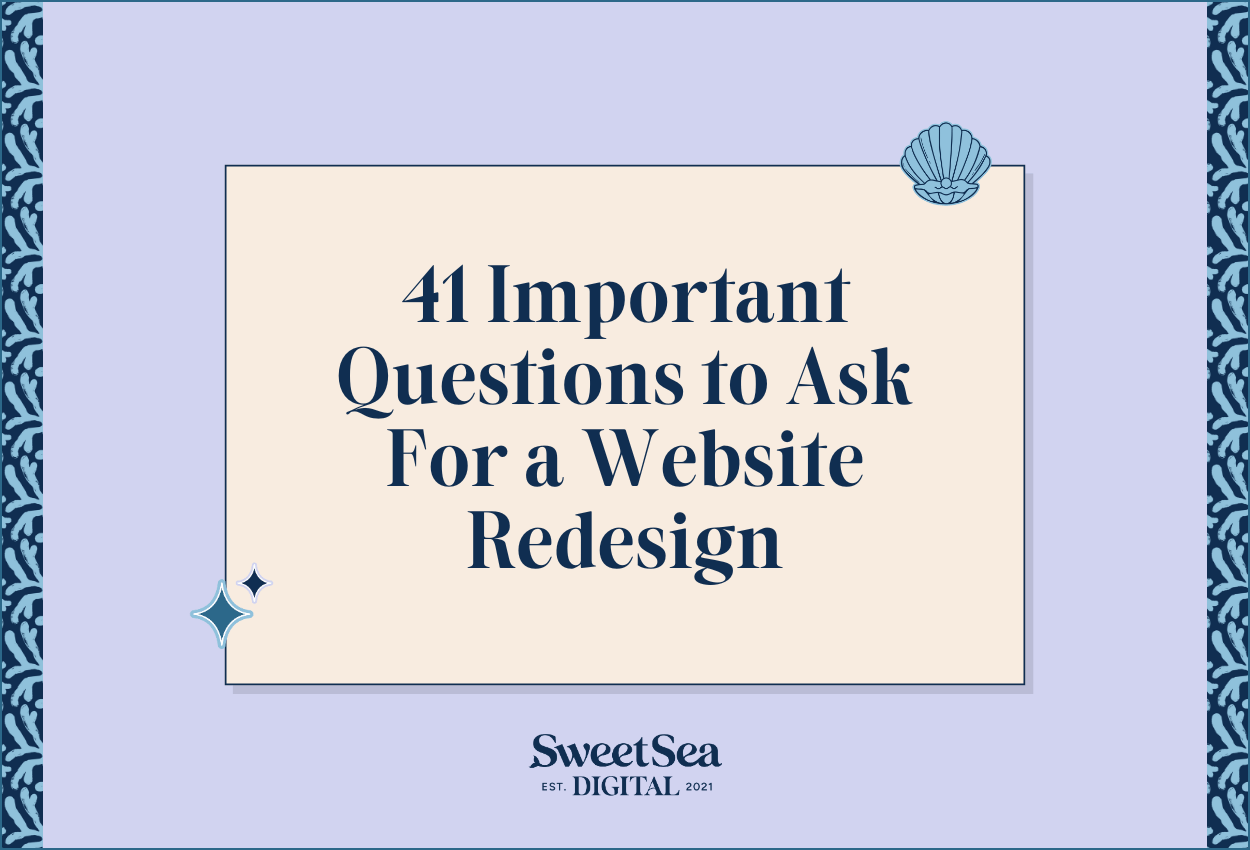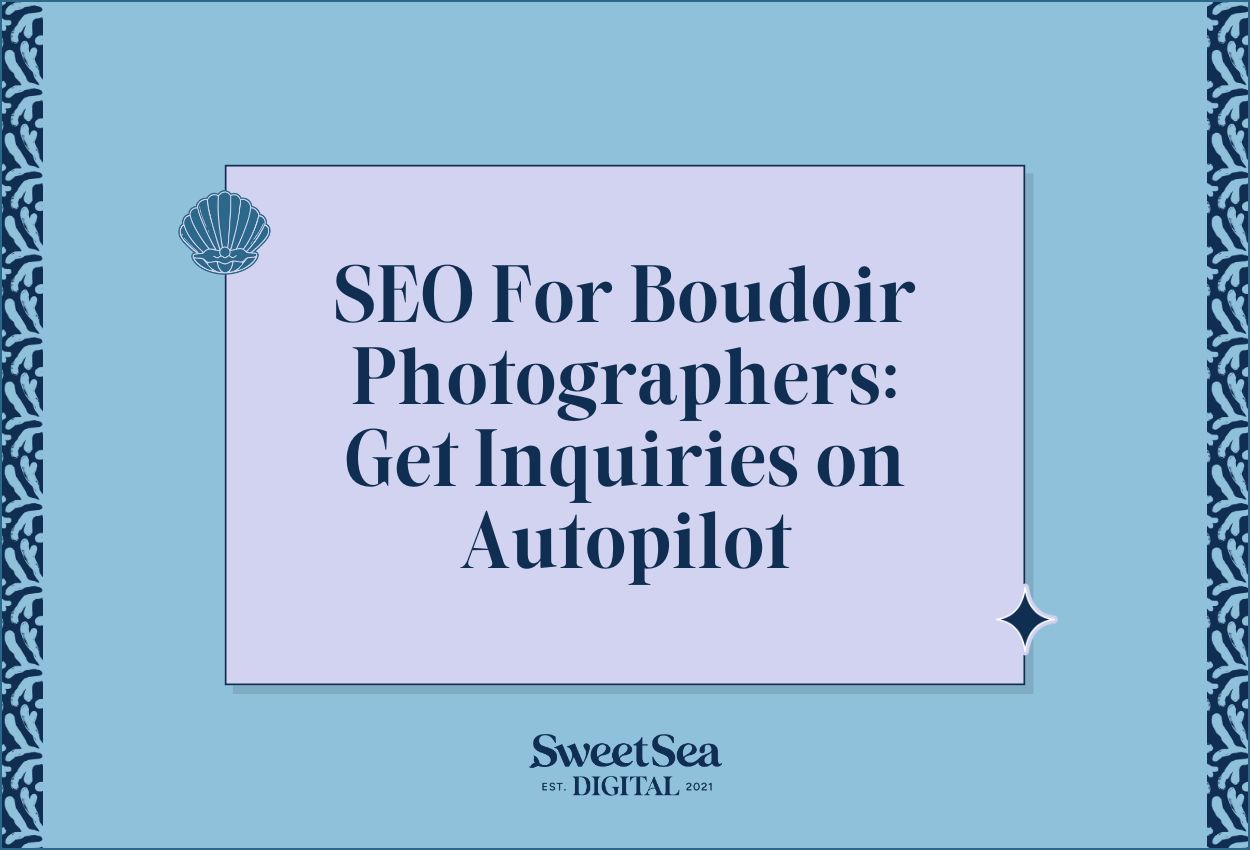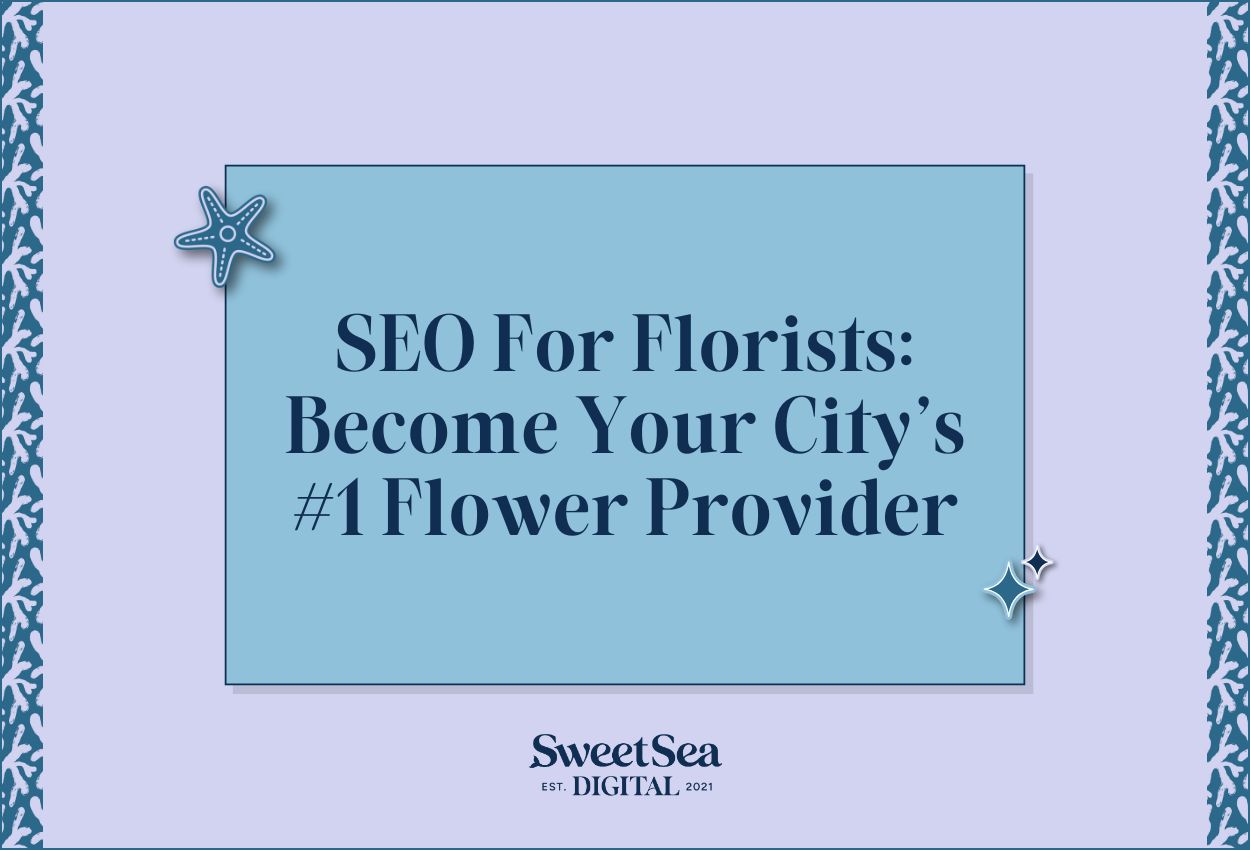Blog vs Newsletter: What’s Better to Start? (2025)
By Seren Nurgun,
Founder of SweetSea Digital
By Seren Nurgun
Jan 27, 2025
Salt Your SEO:
Kickstart Your SEO With These 5 Easy Steps!
As an entrepreneur, it can feel like there are a million marketing channels to choose from. You absolutely don’t need to do all of them at once (even seasoned entrepreneurs don’t do that!) So how do you pick between starting a blog or a newsletter?
Well, if you’re a brand new business owner looking to kickstart your entrepreneurship journey and are struggling to decide what to start and invest your time and energy in, I’m going to answer all your questions. These are two powerhouse marketing strategies that have different benefits, pros, and cons. Your time and energy are limited, so let’s make sure you can make the best decision for yourself.
Let’s Be Clear: What Exactly is a Newsletter?
For product or service-based entrepreneurs, an email newsletter allows you to share valuable information with people who have opted-in to your email list. That last part is important! You should only email people who’ve agreed to receive whatever you’re sending them. If you don’t get their consent, there’s all kinds of legal, business, and ethical problems that happen. The type of content you might share depends on your unique business, your specific business goals, and the purpose of your newsletter. You can send a newsletter every week, every two weeks, or even once a month – there’s no one right frequency.
Here are some examples of what to send:
- Monthly recap newsletter
- Webinar invitation
- New product/service announcement
- A sale on your products/services
- New blog post
- Important business announcement
- Tips and tricks
- A book club recap
- Entertaining personal stories
The beauty of newsletters, especially for business, is they’re a direct line of communication to your subscribers (i.e. people excited to hear from you). You can inject your personality, have fun with it, or even sound super corporate if that fits your readers. Your goal should be to make your emails engaging, interesting, and/or informative. People especially love newsletters that are relatable, funny, surprising, or move them on a deeper level – but make sure any newsletter you start appeals to your desired niche audience.
For non-product or service-based entrepreneurs, you’re probably thinking of newsletters in the context of creating a business directly from a newsletter (like Milk Road and Ben’s Bites). These newsletters can be sent at any frequency (usually daily or weekly), and make their money largely from selling sponsored ad slots in the newsletters themselves. This can get very profitable very fast if you have a great newsletter that a lot of people want to read (like Morning Brew’s meteoric rise).
Let’s Be Clear: What Exactly Is a Blog?
A blog is a collection of blog posts published online that allows the publisher to share their perspectives, teachings, and helpful information. The most common type of blog post answers a commonly asked question. Popular formats include:
- Listicles (list-based)
- How-to guides
- Informational
- Case studies
- Ultimate guides
A blog is often used by small business owners to showcase their expertise and attract new clients/customers. They help A LOT with SEO purposes and saving time by repurposing blog posts into content for other platforms (like pulling out a main point and turning it into an IG post). Done well, a blog can be super profitable in the long-term, especially if you systemize the backend mechanisms to generate passive income.
Pros & Cons of Starting a Blog
Blogging has been around for over a decade, and it’s only getting better. Google has finally started prioritizing high-quality, trustworthy content so those who smartly take advantage of today’s opportunity will come out on top in the long-term. Starting a blog can take a lot of work, but it can definitely be worth it 10x over.
Pro: A Blog Gives You More Opportunities to Be Found on Google
Marketing your products and/or services through a blog is an amazing strategy for many reasons, but my favorite is it brings highly interested people TO you. By consistently publishing on-topic and search engine optimized blog posts, you’re increasing the amount of opportunities and chances to be found on Google. One single blog post can rank for thousands of keywords, so the potential is literally exponential. Entrepreneurs who consistently publish helpful or interesting blog posts are considered more reputable, trusted, and authoritative, which Google tends to reward with high rankings.
Pro: You Can Save Time By Repurposing Blog Posts
Repurposing from long-form content to short-form content is a proven productivity hack for creative entrepreneurs and other business owners. Blog posts fall under long-form content because they’re longer in format than other types of content (like social media posts). Because you’ve put so much effort into a well-written, well-researched blog post, the key to saving time by repurposing is pulling out all of the blog post’s interesting statistics, quotes, opinions, and juicy bits. All of these can be turned into bite-sized, short-form content for social media or even emails. You can generate 8+ social media posts from just 1 blog post!
Pro: It’s Free (If You Already Have a Website)
We all love free things, especially as small business owners. If you already have a website, starting a blog is completely free unless you want to tap into a pro’s expertise and get results a lot faster. If you’re starting from scratch without a website, then of course buying a domain and hosting costs money. After that though, it costs nothing to publish more pages on your website, and the rest comes from that creative brain of yours!
Con: To See The Best Results, You Have to Be Consistent
The biggest con of starting a blog is you can’t just publish once and watch it go viral. It takes consistency for blog posts to perform well because it takes time for SEO (search engine optimization) to kick in and start compounding. That’s because Google loves fresh content and rewards committed publishers who show they’re reputable and trustworthy.
If you’re a small business owner strapped for time, I recommend publishing at least 2 blog posts a month. That’s just 1 every 2 weeks. Aim for at least 1,000 words per blog post for rich, helpful content that your audience will enjoy. But if you don’t have the time or desire, how does getting it ALLL done for you sound? That’s exactly what I do for business owners like you!
Con: You Need Some SEO Knowledge to Rank High on Google
No doubt SEO (search engine optimization) is scary for some people. I’ve seen it firsthand where smart entrepreneurs stay away from it because it feels unknown and difficult (totally valid feelings!).
But if your goal is to rank high on Google, then your blog posts definitely need at least a sprinkle of some SEO magic. Without it, your blog posts would likely end up among the millions of blog posts that no one reads because they’re ranked under 523,780,962 other blog posts on Google.
Are you a total newbie to SEO? Learn the 5 essential SEO steps that need to be locked down (before starting to blog) on your website.
Grab ’em here (for free!):
Pros & Cons of Starting a Newsletter
I’m just going to get this out of the way now – email is definitely NOT dead! There are roughly four billion daily email users – that’s half of the entire world! Email has been and will continue to be a worthwhile marketing strategy (unless of course something absolutely wild happened).
Pro: You’re Talking Directly to Highly Interested People
Because you have to get permission from someone to email them, the fact that they willingly gave you their email indicates a genuine interest in what you’re all about. Whether you got their email from them signing up for your webinar or from downloading your freebie, as long as you highlight the fact that you’ll be sending them emails, you’re good to go. Now, you can pop into their inbox with information related to what they’re interested in and information about your business. That’s pretty dang valuable!
It’s the same ideas as people hitting the ‘follow’ or ‘subscribe’ button on social media platforms. They’re indirectly saying ‘I WANT TO SEE MORE STUFF FROM YOU’. Ok maybe they’re not quite yelling, but who knows.
Note: If you have recipients in Europe, different legal requirements apply. You’ll need to actually get their acknowledged consent in order to send them emails (like putting a checkbox wherever you have an opt-in). Canada and Australia also have some specific opt-in requirements.
Pro: It’s Relatively Inexpensive
Some email platforms are relatively inexpensive (or even free) to use until you reach a certain number of subscribers. Once you reach a certain number of subscribers, you’ll be paying anywhere from $20 USD/month to a couple hundred dollars/month. If you’re looking for a completely free email provider, I definitely recommend Mailerlite. But if you’re looking to make a smart long-term investment, I recommend Flodesk because it’s a flat fee (so how much you pay doesn’t change as your email list grows), any emails you create there are always beautiful, and their customer service is A+ (speaking from experience). I use Flodesk and love it.
Try Flodesk here (try for free, no credit card required and then after 30 days, you’ll get 50% off your entire first year!).
Con: It Takes Some Time to Build an Email List
Although your email list is one of the best places to gain new clients/customers, it definitely takes hard work and at least a few months for it to grow. Again, people are willingly giving you their email address, so you need to create initial content that’s valuable enough for them to want to sign up. To initially get signups, what helps get momentum going is consistently creating entertaining, educational, or inspiring content on social media and then creating freebies (otherwise known as lead magnets). Freebies can be PDFs, trainings, workshops, mini-courses, a private podcast, or literally anything you can think of that your target audience would LOVE.
P.S. Flodesk is awesome because it makes creating beautiful opt-in forms extremely easy. Like no head scratching, saying “WUT”, or getting annoyed.
As nice as it would be to put a freebie out there and have 1,000 people sign up right away, it just doesn’t work like that. And then once that’s all put into motion, it’s best to consistently deliver great content via your newsletter to keep those who grabbed a freebie engaged. If they stop getting value from you, they’ll likely unsubscribe (because who wants to keep getting low-quality emails?).
Con: Building an Email List is Half the Battle
The other half is getting people to actually open and engage with your emails. It’s great if you already have some background knowledge of email marketing to write catchy subject lines, but if you don’t, your emails could fall flat. If people don’t even open your emails, there’s no way they’ll become a client/customer through your newsletter. Only when people start to like what they see, does it get easier for them to open your emails and engage with you in the future.
Get your subject lines analyzed using this free tool (no signup required!). I use it myself time to time.
Major Differences Between a Blog and a Newsletter
There are a few differences between a blog and a newsletter that might be helpful for you to know before deciding which one you want to start with:
| Starting a Blog | Starting a Newsletter |
| Blog posts are public – anyone can access them anytime and read them. | Newsletters are only accessible to your email list unless a subscriber shares them. |
| Blog posts will help improve your website’s SEO. | Newsletters do not impact your website’s SEO. |
| People aren’t notified when you publish a new blog post unless you have systems in place to do that. | Newsletters are sent directly to someone’s inbox. |
| Blog posts are published on your website. | You need an email service provider to send newsletters. |
Major Similarities Between a Blog and a Newsletter
Although there are some key differences between a blog and a newsletter, they also share some important similarities:
- They both require time and consistency to be effective.
- Some sort of marketing strategy needs to be in place to drive traffic.
- It’s relatively inexpensive to get started.
- Both can be lucrative as you grow.
- Sharing value is the number one goal.
If you’re still trying to decide between starting a blog or starting a newsletter, go back to your goals. You’re obviously good at writing if you’re considering these two writing-based marketing avenues, so what are you hoping to achieve? Blogging is great to consistently attract highly interested people to your business, and newsletters are great to engage and deepen your connection with those highly interested people. So ideally, you’d have both. But if your time and capacity are limited, I recommend starting with a blog because you need attention before you can engage people. If you decide on a newsletter, use this tool to come up with the perfect name.
If you’re ready to commit to blogging but don’t know where to start OR want it all done for you, I’m here to help! Check out our monthly, totally done-for-you SEO support.
P.S. If you’re also trying to decide between starting a blog or an Instagram account, check out this post!
Seren Nurgun
SEO pro and founder of SweetSea Digital, Seren has proudly generated over 278,000 organic clicks from Google and worked with awe-inspiring 6 and 7-figure business owners. Ethical, sustainable marketing is her jam.
Read These Next
Before you go any further…
Hi! I’m Seren, the writer!
Hi! I’m Seren, the writer!
An SEO pro since 2021, I’ve generated over 278,000 organic clicks from Google and worked with 6 and 7-figure business owners. Starting, running, and growing a business definitely isn’t the easiest thing you’ll ever do (to put it lightly), so this treasure trove of blog posts is purely focused on making your life that much easier. You’ve found one of my favorite places on the internet, so I won’t hold you any longer - happy reading!
But first!
Start your SEO journey on strong footing.
Benefit from the free Salt Your SEO guide, weekly newsletters with actionable tips, and some promotions you might not want to miss.
We’re not jerks! Your email will never be spammed, sold, or otherwise treated poorly.

FREE
GUIDE
A Boutique SEO Agency For Woman-Led Online & Local Businesses
A Boutique SEO Agency
For Woman-Led Online
& Local Businesses
who are ready to leverage the world’s
#1 search engine & make sales on repeat.
Navigate
Learn
Let's Connect
© 2021-2025 SWEETSEA DIGITAL, LLC
Brand Photography by Halle Alessia
SITE DESIGN BY CREATE & WANDER
Operating from the unceded ancestral homeland of the Tequesta people
Because we value your trust, we want to share that this page may contain unique affiliate links, which means that we may receive a financial exchange (at no cost to you) if you make a purchase. We only recommend the tools that we actually love and 100% ethically stand behind (because you deserve the best!).


